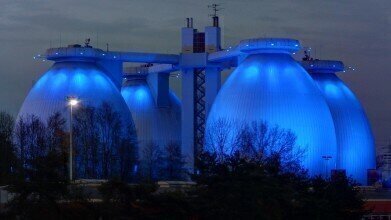Green Energy
How Is Biomethane Made?
May 31 2021
Biomethane is a low-carbon and renewable alternative to traditional fuel sources such as petrol and diesel. Although the production of biomethane does entail the emission of some greenhouse gases, these emissions would occur naturally anyway if the organic matter involved in the process were left to decompose. At the same time, it dramatically reduces the amount of methane that is allowed to escape into the atmosphere, thus limiting concentrations of one of the most potent greenhouse gases.
For this reason, biomethane (alongside shale) has been targeted as a credible replacement for natural gas in British industry. Although 100% clean renewable energy sources (such as solar and wind power) are the ultimate goal, biomethane can provide supplementary fuel that can power our vehicles and replace natural gas in a variety of industrial applications. Here’s how it’s made:
Step 1 – Slurrification
In this initial stage in the process, the raw organic materials are crushed to achieve a finer and more uniform consistency, then combined with water from a later stage in the biomethane production process. At this point, the manufacturers are looking to achieve a ratio of solid-to-liquid matter of 10%-to-90%, since this will greatly aid in the ensuing stages.
Step 2 – Pre-digestion
After slurrification, the slurrified biomass is filtered to remove any unwanted solid particles of waste (such as plastics or other contaminants) and sent to a pre-digestion chamber. Here, the enzymes secreted by bacteria are allowed to feed upon the biomass to break into down into even smaller constituent parts, before being sanitised at a high temperature to prepare it for the next phase.
Step 3 – Anaerobic digestion
This step is the main crux of the biomethane production process. Inside a biogas reactor, the slurrified biomass is subjected to microbes at a warm temperature (around 37°C) for a period of three weeks or more. Over this time, the microbes will feed upon the lipids, fats and proteins in the biomass and convert them into biomethane, composed mainly of methane, some carbon dioxide and perhaps a small concentration of other gases.
Step 4 – Digestate removal
The biomethane mentioned above is collected in a specially designed chamber at the top of the reactor. Meanwhile, the leftover solids and liquids (known as digestate) are separated. The former are processed and used as fertiliser for agricultural purposes, while the latter are recycled by injecting them into the first stage of the process as nutrient-rich water which is combined with the raw biomass materials.
Step 5 – Scrubbing
Before the biomethane can be sold or used commercially, it must be purified via a process known as scrubbing. This involves subjecting the gas to powerful cascades of water at pre-defined pressures and temperatures, which is capable of removing any impurities in it and leaving behind a final product composed of at least 95% (and usually 98%) methane. Ta-da! That’s how biomethane is manufactured.
Events
IWA World Water Congress & Exhibition
Aug 11 2024 Toronto, Canada
Aug 25 2024 Stockholm, Sweden and online
Sep 03 2024 Mexico City, Mexico
Sep 03 2024 Mexico City, Mexico
Sep 03 2024 San Diego, CA, USA














